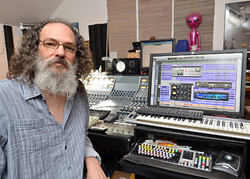Here’s an excerpt of an interview that I did with top mix engineer Andrew Scheps that’s featured in the recently released 3rd edition of The Mixing Engineer’s Handbook.
—————————————-
Andrew Scheps has worked mega-hit albums for a who’s-who of superstar artists like The Red Hot Chili Peppers, Metallica, U2, Justin Timberlake, Jay Z, The Rolling Stones, Linkin Park, Jewel, Neil Diamond and Adele.
Even though he’s working out of his pretty outstanding home studio built around dual Neve 8068s, a massive wall of outboard gear, and dual Studer A800 24 track tape machines, amazingly Andrew is not one still living in the analog past, as the DAW is an integral part of his workflow.
Can you hear the final product in your head before you mix?
Andrew Scheps: If I know the song then I already have a pretty clear picture of what I’d like it to be. If not, I’ll usually get that the first time I listen through a track. It’s not so much for the sonics, but more in terms of size, like figuring out how big the chorus will be. Sometimes I’ll get really specific ideas about effects that I’ll try as well.
In terms of starting a mix, I think the main thing, especially if it’s a song I haven’t recorded, is that I go through instrument by instrument to see how it sounds, but what I’m really doing is learning every single part so that I when I come to build my balance, I know where everything is going to be.
Do you have a template for your effects before you start to mix?
Andrew: Kind of, although I don’t use a lot of effects. I use a lot of parallel compression so that’s more of what I have set up. In terms of what gets sent to those compressors, some of it is consistent and some of it changes with every mix, but they’re ready for me at the push of a button, which on an analog console is great because I just leave that part of the patchbay alone.
In terms of effects, sometimes I’ll have one kind of chorus-spreader kind of thing and one reverb and that’s it. I don’t tend to use many effects because a lot of the stuff I mix is straight up guitar rock and it’s more about the balance and making things explode.
Do have an approach to doing that?
Andrew: You’re never really as aware of your own process as you think you are. I’ll think that I really didn’t do much of anything and then I’ll look at a mix and find that I’m using 50 things on it.
Also, because I mix on a console there’s the whole process of laying out the outputs of Pro Tools to see where everything is going to come up on the console. There are things that always live in the same place, like channel 24 is always the vocal, so I’m usually figuring out how to lay out everything between the drums and the vocal. I do that while I’m finding out what everything is doing, so there’s a long discovery process where it doesn’t seem like I’m getting much done, but then everything happens really quickly after that.





















